“Approaching the Unknown” Filmmaker Mark Elijah Rosenberg on the Agony and Joy of Making Art
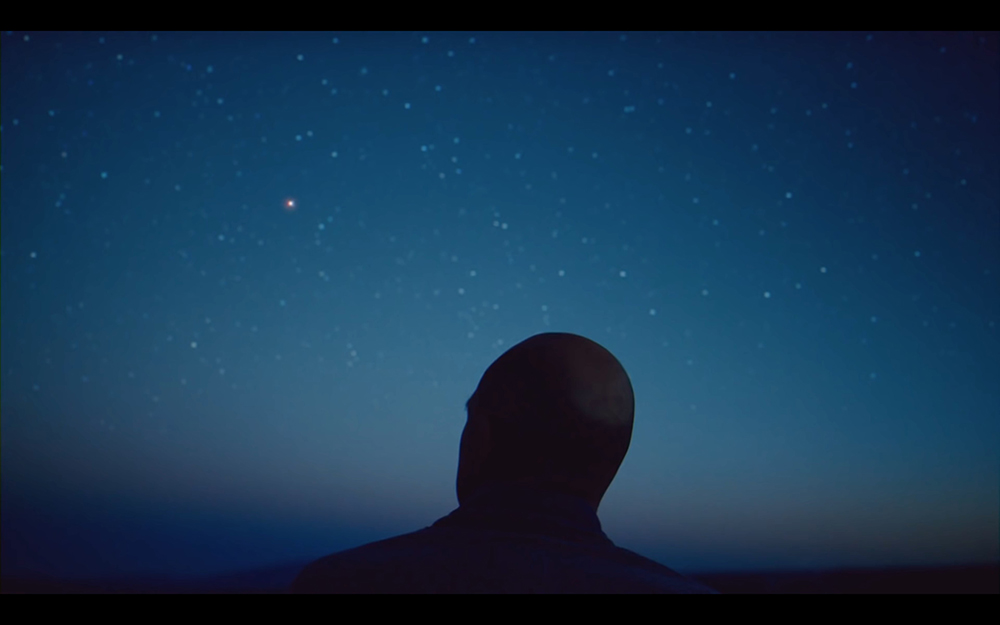
On June 3, Mark Elijah Rosenberg’s Creative Capital project, Approaching the Unknown, will be released theatrically in ten cities (see list at bottom of post), and available on-demand. The story follows Captain William D. Stanaforth (played by Mark Strong), an astronaut on a one-way solo mission: taking humanity’s first steps toward colonizing Mars. Although the entire world is watching him, he is completely alone in a dark and distant sea of stars. Stanaforth rockets bravely through space facing insurmountable odds, but as the journey takes a toll on his life-sustaining systems, he is forced to make impossible choices that threaten his sanity, mission and very existence. Approaching the Unknown received the Creative Capital award in 2012.
I connected with Mark to learn more about the evolution of this ambitious project and struggles encountered along the way.
Jenny Gill: Approaching the Unknown is (obviously) a work of fiction, but you mentioned in your presentation at the 2013 Creative Capital Artist Retreat that there are elements of your personal life experience and desires in the story. Can you talk about the balance between the personal and the imagined in your writing?
Mark Elijah Rosenberg: No, it’s not fiction—we really sent a man alone on a one-way mission in space! Or at least, that would’ve been easier and quicker.
Approaching the Unknown is about an astronaut on a journey to set up a colony on Mars. He knows he’s never coming back to Earth, and he’ll be alone for a while, but within a few years he’ll be joined by dozens then hundreds of other people. There are some lines of voice over that never made it into the film where Stanaforth, the astronaut, relates his experience to that of his grandfather, immigrating to America, and his ship being just like a boat sailing across the Atlantic. But is that the comforting story we tell ourselves so we can do something adventurous, or is it naive and hubristic to think any worthwhile adventure in life can ever be a cakewalk? That’s the line Stanaforth is walking, and it’s a line anyone with ambition has to balance upon. What’s brave and what’s stupid? To do anything amazing, you do need experience and knowledge and confidence. But at a certain point, you also need to push yourself into the new, the unknown, the frightening.
For me personally, I want the characters in my films to struggle toward a sense of wonder, so they inspire me (and the audience) to find beauty and magic everywhere in the world around them. But I also need them to push the limits of human experience and interaction, in order to find brilliance, and see if they can survive.
When I talk about Approaching the Unknown as a personal story, well, the first question I was asked when I was developing the script at the Sundance Labs was: Would I go on this mission? And I had to sheepishly reply: No.
I had just gotten engaged (and am now happily married), and as much as I’ve always thought of myself as a loner and an outsider, someone who would happily isolate myself in order to do something grand, when the possibility of a life alone was posed to me (fictitiously!), I couldn’t bring myself to do it. And that’s the emotional struggle the character deals with in Approaching the Unknown: is he willing to be completely alone if, in exchange, he attains some kind of enlightenment, or delivers something inspirational for all mankind? Would I give up my relationship, my family, my home, everything I’ve ever known, to…make a work of art? To challenge a political system? To invent a world-changing machine? I want to do those things, but would I sacrifice? Do I have to?
For me personally, I want the characters in my films to struggle toward a sense of wonder, so they inspire me (and the audience) to find beauty and magic everywhere in the world around them. But I also need them to push the limits of human experience and interaction, in order to find brilliance, and see if they can survive.

Mark Strong (left), Mark Elijah Rosenberg (center) and Adam Newport-Berra (director of photography, right) on the set of “Approaching the Unknown.” Photo by Irwin Seow.
Jenny: This is your first feature film, and it’s a major production with a well-known lead actor (Mark Strong). How did you pull it off?
Mark: It was a real struggle. The whole project changed a lot from my initial plans to production, and that was (for better and worse) how it got made. Originally, I had planned on renting a bus, building out the inside like a spaceship, and having an actor live in it for 30 days with a loose storyline, cameras always rolling, and outside direction from me and online participation from strangers. I had some adventurous producers come on board, but they were still film producers, and so the idea changed to building a set in a warehouse, and shooting a few days and taking a few days off to edit and discuss, but still partially discovering the story through structured improvisation and durational experience with a very small crew.
But we still didn’t have any money, though, and the script received support from the Sundance Labs and from the San Francisco Film Society, which pushed the project into more traditional development channels, until eventually we mustered some conventional indie film financing. That meant making the movie in a conventional way: a set script, a full crew, 18 days of shooting.
I had a lot of hesitation about that method, for this project in particular, because my vision was not inherently dramatic (in an archetypal sense) but rather atmospheric and experiential. But it turned out to be easier to raise a million dollars for a traditional production than to raise $300,000 for an experimental process. From then on, I wouldn’t quite say there were explicit strings attached with the financing, but it moved it closer to a conventional narrative. Maybe I would’ve had more freedom if I’d stuck to my original scheme, but more likely I would’ve never made the thing at all!
And all that said, I had an amazing opportunity to create something cool with an incredible team of people. Mark Strong, the lead actor, is not only an astonishingly talented performer, but he’s generous and intelligent and funny. I learned so much from him, and I couldn’t have had a better partner to work with on my first film. Our production designer, Steven Brower, is a genius who brought so much passion and insight and creativity to the set and the script. He was the backbone of the whole thing, and the piece would’ve collapsed without him. Our DP, Adam Newport-Berra, is a hard-working visionary. When for so long I’d been imagining the film as this inscrutable rock hurled at the audience, his eye opened it up, brought it to life, made it beautiful and poetic. And the FX team, led by Ray Tintori and Rob Leitzell, were just a whirlwind of focused energy, who pulled a madcap scheme from thin air and made it real. There are many, many others, too, but the point is, for all the struggle, I was extremely lucky to have this vision get made.
Jenny: Last summer, you sent us some great photos from artist residency programs in upstate New York. Tell me more about those programs and how they contributed to the development of the film.
Mark: Yeah, last summer I was lucky enough to attend two residencies in upstate New York, at the Wassaic Project and at the Catwalk Institute.
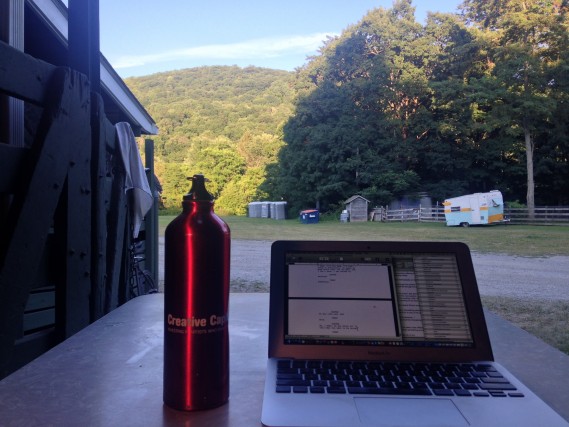
At the Wassaic Project Residency, Summer 2015
I was at Wassaic while taking a break from Approaching the Unknown, and that was tremendously helpful. My first week up there, I was miserable. I’d been struggling for so long with Approaching that even when I knew I wanted to step away from it for a bit, I felt like a failure and like I’d never have any more ideas. But I knew I had a month just to mess around with something new, so I was editing old video footage I’d shot years earlier, and taking long lonely walks. I got back into painting, or this type of archeological collage thing, and the suffering and the giving up and working wildly with my hands (rather than being stuck in my own head trying to write) finally freed me up. I wrote a whole new script in 18 days, working on a very satisfying schedule: writing from about 10-6 and feeling good enough about myself that at night I could have dinner with my wife or hang out with some of the other artist residents or watch a Mets game (they were surging into first place at the time) without all the guilt I usually have that I haven’t done enough with my day.
And I guess I should say that I wasn’t entirely taking a voluntary break from Approaching the Unknown at the time. There was actually another editor working on the film at the time, pretty much against my will, and at the end of my month at Wassaic he had a cut that I abhorred. But that also re-fueled my energy to dive back into the film, which I was able to do at Catwalk. So then I had a month up there (the duration of the residency and the deadline given to me by the film’s producers) to make a final cut of the picture on my own. For the first time in the editing, I knew explicitly what I didn’t want in the movie, and I had a clear sense of the feeling I did want. But I had to make it happen, which was incredibly hard.
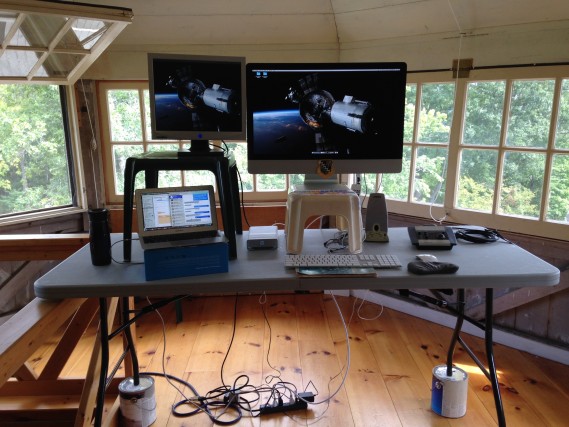
Mark Elijah Rosenberg’s “editing suite” at the Catwalk Residency
Unlike at the Wassaic residency, where there was a whole community, I was almost completely alone at Catwalk—in a lighthouse tower, overlooking the Hudson Valley, so high up that I literally looked down on an eagle flying by one day. It was just me and the material, and it was brutal. I fell back into a lunatic schedule, working till dawn, sleeping till noon, banging my head till midnight, working till dawn… Again, I often felt like a failure, like I had no idea what I was doing, that I’d never make it work. And in some ways, the film isn’t everything I hoped it would be, but what I realized from both of those residencies was that as long as I was suffering because of a struggle with my art, that’s what I wanted to be doing. When I’m back in my “regular” life, and I’m having trouble working creatively, I get caught up in all kinds of other distractions and turmoil (day jobs and social obligations and chores). At those residencies I could focus on that one particular agony (and joy)—making art.
Terribly angsty and dramatic, I know. I’m trying not to be…
Jenny: It’s okay, angst away! Beyond the feature film, you mentioned that you envisioned installation and performance expansions of Approaching the Unknown. What would they allow you to accomplish that the film did not?
Mark: The nature of this story is not dramatic; it’s anti-dramatic. The character has already made the biggest decision of his life (to leave Earth forever) before the story begins. Thus, the story is about the evolution of a character as he comes to terms with that decision, as he realizes who he thought he was and who he is. At the beginning, he thinks he knows just what’s going to happen, he thinks he can solve any problem, he thinks he can handle any situation. But he gets smacked in the face by his own limitations, his own flaws, and by the vast complicated nature of the universe, which no one person will ever understand or comprehend. So the thing I wanted to capture was this slow dissolution of character, and this awakening into a state of madness and bliss. I didn’t want to focus on story and narrative beats, but on mood and ideas.
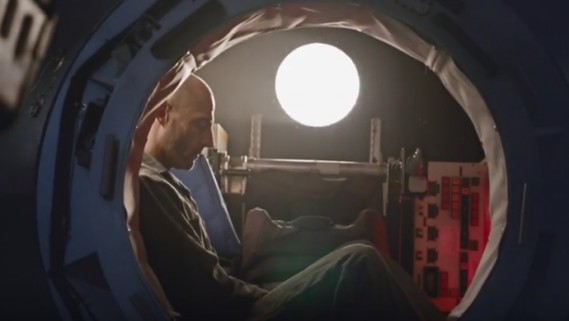
Mark Strong in “Approaching the Unknown”
Like Rimbaud saying, “The poet makes himself a seer by a long, prodigious, and rational disordering of all the senses. . . This is an unspeakable torture during which he needs all his faith and superhuman strength . . . He reaches the unknown; and even if, crazed, he ends up by losing the understanding of his visions, at least he has seen them! Let him die charging through those unutterable, unnameable things: other horrible workers will come; they will begin from the horizons where he has succumbed!”
Or Hamlet: “I could be bounded in a nutshell and count myself a king of infinite space were it not that I have bad dreams.”
Or Bas Jan Ader, hanging to the point of exhausting, then falling, over and over again, and disappearing.
Or POWs angry at being traded for enemy captives, because why did they fight and suffer and die if the cause was not something worth dying for?
Or the idea that by stripping yourself of all the trappings of life (on Earth) you can tap into your own soul more clearly. By denying all sensory experience, and coming near death, you would also come into physical contact with, and understanding of, the universe at large.
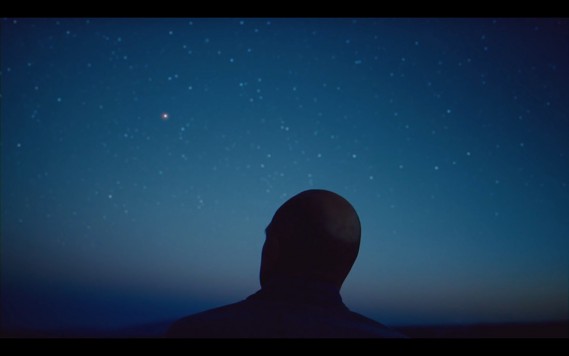
Still from “Approaching the Unknown”
So what I wanted, above all, was the time to let all these concepts unfurl, and boil, and glow. And maybe any single viewer of the 30-day installation wouldn’t get it all, but they can’t get it all in an 80-minute film, either. At least in the durational and experiential performance it’s all present, and therefore authentic. So I hope people can catch glimmers of these concepts in the film, or make their own connections, have their own nutshell dreams. Because some of my favorite scenes in the film are the quietest ones, where you’re present with Stanaforth while something—the sun, or some drops of water, or tiny particles passing through his eyes—causes a shift in his feelings, or an evolution of his ideas. Those are the moments I dreamed of at the very core of this piece—installation and film.
The converse of the installation’s breadth, of course, is that in the film you get focus, intensity, completeness. The viewer can grasp the entire evolution of the character, can catch every word and movement and perhaps deduce every present idea. Which is great, if the ideas are clear and strong. The film becomes much more literal: what you see is what you get. We did a lot of scientific research into what life would be like on a long-distance space mission—everything we got right is a credit to Steven Brower, and everything we got wrong is my fault. Because I wanted to break from those literal confines. A lot of people will question the logic of sending one man alone (though space agencies have devised rational plans to do so), or the logistics of the mission control / space ship oversight (which intentionally breaks convention of the micro-managed, over-determined mission), or various other details. But I hope that people see those facts not as flaws but as metaphoric choices.
The most obvious digression from reality is that in our movie space itself has texture. This was important to me because the only way I could comprehend being in deep space would be like being deep in the ocean: it’s vast and dark and deadly and seemingly empty, but of course it’s also filled with bacteria and minnows and whales and quarks and comets and planets. To understand the ocean, even if you’re in it, you need to imagine it. So Stanaforth’s experience of space must likewise be subjective. At the beginning of the movie, we present a more traditional, literal outer space: blackness with tiny white stars; by the end of the movie, Stanaforth is moving through a maelstrom of viscous chaos.
It’s not realistic, but neither is it imaginary.
I think that paradox is something we couldn’t achieve in the installation but did capture in film, because we could take the time to physically make these beautiful space textures (in glass tanks filled with glycerine, salt water, dyes, glitter and light!) and have our real actor interact with this subjective concept.
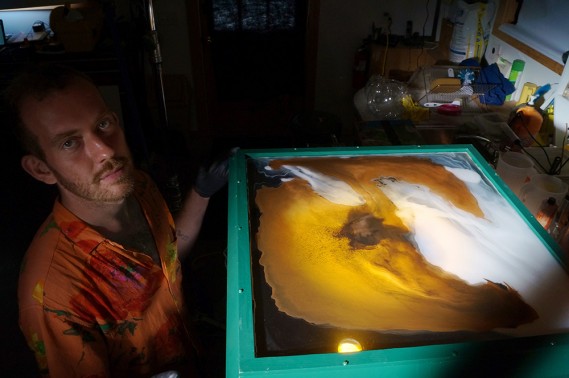
Cloud Tank Artist Paul Korzan creating outer space textures for “Approaching the Unknown.” Photo by Danny Garfield.
Jenny: I can’t wait to see it! Thank you for being so open about the complexities of making a film on this scale—the successes and the failures. As you look back on what you’ve learned over the years, do you have any advice for young filmmakers and artists out there?
Mark: Trust your instincts, find good collaborators, put all your heart into your work, bring a change of socks and a toothbrush.
Mark Elijah Rosenberg’s film “Approaching the Unknown” will be released theatrically on June 3 and available on demand through Paramount and Vertical Entertainment.
